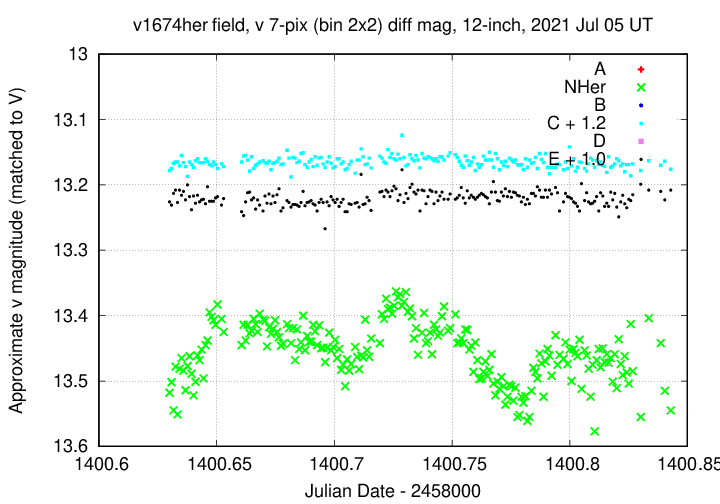
On the night of Jul 04/05, 2021, under good conditions, I acquired images of Nova Her 2021 = V1674 Her. One can find information about it at
The star has faded to V = 13.5 or so, at which point the noise in my 60-second images is growing large. I'll have to switch to unfiltered images in the future.
Also, I discovered that guiding with 3-second exposures is better than 5-second exposures, at least tonight (in a field with plenty of possible guide stars).
This object was discovered by Seiji Ueda (Kushiro, Hokkaido, Japan) on 2021 June 12.537 UT. It rose quickly, then fell quickly.
The main setup was:
Notes from the night:
The object is located at
RA = 18:57:30.95 Dec = +16:53:39.6 (J2000)
A chart of the field is shown below. The size of the chart is about 31 x 26 arcminutes.

I've marked the location of several comparison stars as well. See
I'll use star "E" to shift my instrumental magnitudes to the V-band scale. It has a V-band magnitude (according to AAVSO chart X26675JQ) of 12.221, and (B-V) = 0.608.
The faint star marked "var" shows variations of size roughly +/- 0.3 mag in a roughly sinusoidal pattern over the run. It's perhaps an eclipsing binary. The star has magnitude V ~ 13.5 and position
RA = 18:57:04.13 Dec = +16:46:00.9 (J2000)
= 284.26722 = +16.76692
You can use its entry in the APASS catalog to look it up in Vizier, and to serve as a cross-reference.
I took a photo of the finder TV's screen when pointing to this target; this could be a useful reference for the future:
The sky value shows just a couple of brief bumps due to light clouds.

The FWHM graph below shows quite a bit of scatter. I used X aggr setting of 3 all night. At the start of the night, I was using a 5-second guider exposure time, but I switched to a 3-second exposure time around JD = 400.75. Note that the scatter decreases at that time. I will try to use short exposure times for the guider in the future, if there are stars bright enough to permit it.

Using aperture photometry with a radius of 7 pixels in a V filter (binned 2x2, each pixel is 1.24 arcsec, so a radius of 8.7 arcsec), I measured the instrumental magnitudes of a number of reference stars and the target. Following the procedures outlined by Kent Honeycutt's article on inhomogeneous ensemble photometry, I used all stars available in each image to define a reference frame, and measured each star against this frame.
Sigma-vs-mag plots show that the floor was about 0.006 mag with a 60-second exposures. The outlier at instrumental mag = 4.53 is the target, The faint variable is the slightly larger outlier at mag = 4.63.

Some of the changes in image-to-image zero-point are due to trailing; I ended up keeping 217 out of 272 images.

Here is the light curve of the object and several field stars in the V filter; I've shifted the instrumental magnitudes so that star "E" = 000-BMD-913 on AAVSO chart X26675JQ has the value given by AAVSO as its V-band magnitude. The faint variable star is labelled as "X".

Note the low signal-to-noise of the target, due to its faintness. I'll switch from using a V filter to no filter in the future.

Can we still see any of the variations with period of about 8.4 minutes? I tried using the Periodogram tool at the NASA Exoplanet Archive, but there were no peaks near the value of 0.0058 days, which corresponds to 8.4 minutes.
I have submitted these measurements to the AAVSO, CBA, and VSNet.
You can download my measurements below. A copy of the header of the file is shown to explain the format.
# Measurements of Nova_Her_2021 made at RIT Obs, UT 2021 Jul 5, # in good conditions, # by Michael Richmond, # using Meade 12-inch LX200 and ATIK 11000. # Exposures 60 seconds long, V filter. # Tabulated times are midexposure (FITS header time - half exposure length) # and accurate only to +/- 1 second (??). # 'mag' is a differential magnitude based on ensemble photometry # using a circular aperture of radius 7 pix = 8.8 arcseconds. # which has been shifted so AAVSO 000-BMD-913 has mag=12.221 # which is its V-band magnitude according to AAVSO. # # UT_day JD HJD mag uncert Jul05.12993 2459400.62993 2459400.63445 13.518 0.031 Jul05.13078 2459400.63078 2459400.63530 13.502 0.030 Jul05.13163 2459400.63163 2459400.63615 13.545 0.045
Last modified 7/05/2021 by MWR.